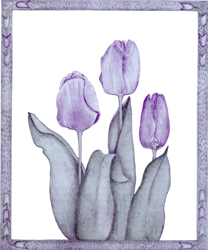
- What Is a Bulb?
- Terminology
- Site Selection
- Bed Preparation
- Selecting Bulbs
- Planting
- Care and Maintenance
- Naturalizing Bulbs
- Forcing Bulbs
- Disease and Insect Control
- Recommended Bulbs
- Commonly Grown Bulbs Suitable for Georgia (table)
- Additional Bulbs to Try
A wide variety of bulbs grow well in Georgia. Most are grown for their flowers and some for their foliage. They are grown as pot plants, in shrub borders, naturalistic plantings and in mass displays. Bulbs offer a certain magic to the landscape virtually unrivaled by other plants.
What Is a Bulb?
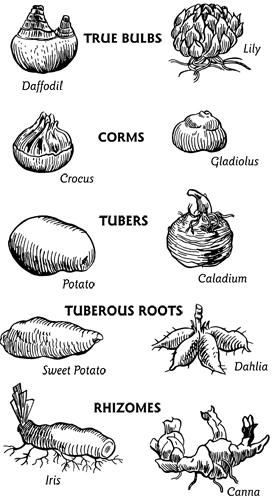 Figure 1. Specialized storage organs, often referred to as bulbs.
Figure 1. Specialized storage organs, often referred to as bulbs.The term "bulb" is used in this publication to refer to true bulbs and other bulb-like structures such as corms, tubers, tuberous roots and stems, and rhizomes (Figure 1). The primary function of these modified plant parts is food storage to ensure the plant's survival during adverse weather conditions. Distinguishing among these structures is important, since each is handled differently with respect to culture, propagation and care.
A bulb is a specialized underground organ consisting of a short, fleshy, usually vertical stem axis (basal plate) bearing at the top a growing point or a flower bud enclosed by thick, fleshy scales. There are two types of bulbs: the tunicate or laminate type represented by the daffodil and tulip, and the non-tunicate or scaly type represented by the lily. Small bulbs called bulblets form at the base of the mother bulb and, with some lilies, along the underground stem. Some plants also produce aerial bulbs called bulbils.
A corm is the swollen base of a stem axis enclosed by dry, scale-like leaves. Examples include crocus and gladiolus. In contrast to a true bulb, a corm is a solid stem structure with distinct nodes and internodes. Small corms produced around the base of the old corm are called cormels.
A tuber is a modified stem structure that develops on underground stems. Examples include Irish potato and caladium. A few plants produce small aerial tubers known as tubercles.
Some sources make a further distinction among tubers, referring to structures that arise primarily from enlarged stem tissue as tuberous stems. These structures, in tuberous begonia and gloxinia for example, develop at the soil surface.
Certain species of herbaceous, perennials such as sweet potato and dahlia produce thickened underground roots. These structures are called tuberous roots (fat roots or fleshy roots) and have the same external and internal structure as normal roots.
A rhizome is a specialized stem structure in which the main stem of the plant grows horizontally at or just below the soil surface. Examples include iris, canna, and lily-of-the-valley. Rhizomes bear the same internal and external structure as true stems.
Terminology
Bulbs are often categorized according to their hardiness, time of bloom, and size.
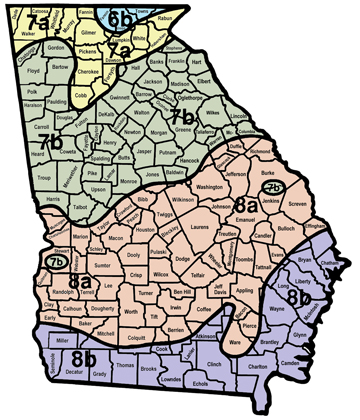 Figure 2. USDA plant hardiness zones for Georgia.
Figure 2. USDA plant hardiness zones for Georgia.Under normal conditions hardy bulbs are those that survive cold climates. Semi-hardy bulbs are those that are hardy in milder climates but not reliable in colder climates without protection. Tender bulbs do not tolerate freezing and can be left in the ground only in warm climates. Georgia has three district USDA. hardiness zones (Figure 2). Your location will determine which bulbs are hardy in your given area and will influence time of bloom. Bulbs will flower two or more weeks earlier in Zone 9 than in Zone 7.
Spring-flowering bulbs consist largely of the so-called Dutch bulbs. Planted in the fall, they bloom the following spring; most spring flowering bulbs are completely hardy in Georgia. Summer-flowering bulbs include hardy to tender bulbs that flower in summer; some summer-flowering bulbs continue to flower until frost. Fall-flowering bulbs, consisting largely of a few hardy bulbs, flower in late summer or early fall. The term winter-flowering generally refers to tender bulbs simply forced to bloom out-of-season indoors. A few bulbs bloom outdoors in very early spring and are sometimes called winter-flowering.
So called minor bulbs are small in stature compared to the larger, showier bulbs. They can be used to great advantage in the landscape. Many, such as crocus, are especially valued because of their early flowering habit.
Site Selection
Most spring-flowering bulbs prefer light shade to full sunshine. Try to select a site that provides at least 6 to 10 hours of direct light per day. This need not restrict their planting to areas that are in full sun year round. Because many spring-flowering bulbs bloom and produce foliage well before most deciduous trees leaf out, they get plenty of sun under the canopy of such trees, which offer dense shade later in the season. Light requirements for other bulbs, especially the summer bulbs, are more variable. Select a spot where they will receive the recommended amount of light. Insufficient light usually results in poor flowering, but too much light will bleach the flowers and foliage of some species.
Also consider locating beds and plants where they will be aesthetically pleasing and effectively arranged in the landscape.
Bed Preparation
The majority of bulbous plants are actually less particular about soil than many other cultivated plants. Most, however, prefer a moist, well-drained medium sandy loam that does not remain wet and sticky after heavy rain or dry out too quickly. Good drainage is essential. If in doubt, test for drainage before planting. Dig a hole about a foot deep and fill it with water. The next day fill the hole with water again and see how long it remains. If the water drains away in 8 to 10 hours, the soil is sufficiently well drained to grow most bulbs.
If drainage is a problem or if the soil is too sandy or a heavy clay, you may need to use a soil amendment. Peat moss, bark, rotted sawdust, compost, perlite, vermiculite, coarse sand and many other materials have been used successfully. The type of amendment needed depends on the structure and texture of the existing soil, drainage, and the type of bulbs to be grown. Spread several inches of material on the soil surface and thoroughly incorporate it. In extreme cases, you may need to install drainage lines or construct raised beds to ensure good drainage.
A pH of 6.0 to 6.8 is best for most bulbs. Incorporate lime if a soil test indicates a need for it. In the absence of a soil test, add 1 to 2 pounds of 5-10-10, 10-10-10, or 8-8-8 fertilizer per 100 square feet of bed space. Organic fertilizers such as bonemeal are often recommended for bulbs, but they are probably no better than inorganic sources used at the proper rates. Incorporate lime, fertilizer, and any soil amendments thoroughly and deeply, at least 12 inches. Do not attempt to work the soil when it is too wet. If you can crumble the soil between your fingers, it is dry enough for digging and planting.
Selecting Bulbs
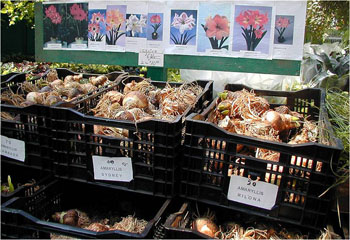 Photo by: Bodie Pennisi
Photo by: Bodie PennisiBulbs are sold in a variety of retail outlets. Always buy from a reputable dealer. Avoid bulbs that are soft or look molded or discolored. Bulbs should be firm and have unblemished skin. There is a direct correlation between the quality of the bulb and the quality of the flower produced; bargain bulbs are no bargain! Spring-flowering bulbs purchased in the spring are simply leftovers from the previous fall and are virtually worthless.
Bulbs are generally graded and sold according to size, usually circumference. Large bulbs produce larger and/ or multiple flowers. The largest bulbs are not necessary for good landscape effect. In most cases, medium grades are entirely satisfactory.
Planting
Plant spring-flowering bulbs in the fall. In Georgia, spring-flowering bulbs can be planted from October through late December in most areas. If you cannot plant the bulbs right away, store them at around 60-65 degrees F. in a dry area. Temperatures above 70 degrees F. may damage the flower buds. In areas of the state with extremely mild winter climates, it may be desirable to pre-cool some bulbs. Most spring-flowering bulbs require a 12-16 week cold period in ventilated packages in the bottom of your refrigerator at 40-50 degrees F. before planting. Check with your bulb supplier to determine whether the bulbs you purchase have been pre-cooled or whether you may need to give them a cold treatment.
Summer-flowering bulbs are planted in spring after the danger of frost has passed.
Planting depth and spacing are very important to the success of bulbs. A general rule of thumb for planting depth (from top to bulb to soil surface) is two to three times the greatest diameter for bulbs 2 inches or more in diameter and three to four times the greatest diameter for smaller bulbs.
Spacing will vary from 1 to 2 inches to as much as several feet. When spacing bulbs, consider not only how much space each plant needs, but also how frequently it will be dug and divided. Also, consider the landscape effect. Avoid spotty or line-out arrangements. It is sometimes suggested that bulbs be broadcast over the area to be planted in order to achieve a naturalistic look; this is unadvisable, however, because dropping or throwing the bulbs may bruise or injure them.
Plant the bulbs upright (rhizomes and tuberous roots are usually planted on their sides), and press the soil firmly around them. Water the beds thoroughly to help settle the soil.
Care and Maintenance
Mulches or ground covers may be necessary to ensure winter survival of some bulbs. They not only minimize winter injury, but also provide a background against which little bulbs show to better advantage. Mulch also prevents mud-spattering from heavy rains that frequently spoil the flowers. Pine straw, bark, fall leaves, and many other organic materials make satisfactory mulches for bulbs.
Mechanical protection may be required to prevent wind damage. Wind breaks or staking may be necessary for tall plants like lilies. There is no effective means of providing cold protection once the plant is in bloom. While late or severe cold waves occasionally spoil spring-flowering bulbs, the bulbs are amazingly resilient and many withstand severe cold.
A well-prepared bed should require little cultivation except periodic weeding. Many spring-flowering bulbs are "overplanted" with other plants, frequently annuals. Be sure not to dig so deeply as to damage the bulbs. When the bulbs flower, fertilize them again using the fertilizers and rates previously mentioned. When the flowers fade, cut them off to prevent seed formation. It is best not to cut or remove the foliage until it dies naturally. Most spring-flowering bulbs produce foliage in fall or early spring that dies by late spring or early summer. Summer-flowering bulbs produce their foliage in spring; it usually remains until cold weather kills it in the fall. Most of the fall-flowering bulbs produce foliage when the spring-flowering bulbs do; they simply flower at a different time.
Normal rainfall usually provides enough moisture for spring-flowering bulbs but not for summer-flowering bulbs. During dry weather, provide supplemental irrigation at weekly intervals. Soak the ground thoroughly. Bulbs have a much higher water requirement when in active growth than when dormant.
Eventually almost all bulbs become overcrowded and must be divided and replanted for best effect. The length of time depends largely on the bulb's ability to produce bulblets. Some may remain undisturbed for many years while others may require dividing every two to three years. Do not dig bulbs until the foliage has turned yellow and withers. Be cautious when digging so as not to damage the bulbs.
Bulbs and corms can be gently pulled apart. Tubers and rhizomes may be cut into pieces, each division containing at least one eye. Tuberous roots can be split apart. Some tuberous roots, like dahlia, also require that a small piece of crown tissue remain attached.
Wash off any soil that clings to the bulb. The bulbs can be replanted immediately or stored for later planting. Store in a dry place away from sunlight, preferably at 60-65 degrees F. Be sure to provide good air circulation. Discard any bulbs that appear diseased.
Remember that tender bulbs will need to be dug in early fall and stored over winter for replanting the following spring.
Naturalizing Bulbs
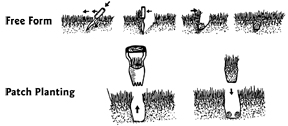 Figure 3.
Figure 3.You can use several methods to naturalize bulbs in the landscape. The first is to randomly scatter self-establishing bulbs such as daffodil and crocus on the ground before leaf drop in the fall. These bulbs will root and establish themselves under the leaves by spring. Another method is simply to dig several shallow pits in the soil under wooded areas and lay the bulbs right side up and replace the soil. The third method involves inserting crocus bulbs under the thatch of your lawn, so the crocus will fill your lawn with color prior to the greening of the grass. Crocus finish most of their food storage activities prior to the first mowing of the grass, so this combination works out very well. However, application of herbicides can affect crocus bulbs adversely, so consult your county agent if you have any doubts. Naturalized bulbs all need to be fertilized in the fall and just after flowering to maintain full vigor. In many areas of the country, failure to fertilize will result in gradually declining bulb populations.
Forcing Bulbs
You can force bulbs to bloom indoors earlier than they normally would outdoors. Crocus, galanthus, hyacinth, narcissus, daffodil, scilla and tulip are easier to force than most.
Pot the bulbs in October or November using a well-drained soil. The number of bulbs per pot will vary according to pot and bulb size. Keep them in darkness at about 40 degrees F. for 8 to 12 weeks in a cold frame outdoors or in an unheated garage or basement, or in your refrigerator. (The bulbs must not be allowed to freeze). Do not allow the soil in the pots to dry out.
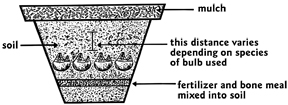 Figure 4.
Figure 4.After 8 to 12 weeks, the root system should be extensively developed and the shoots emerging from the bulbs. Move the pots to a cool, well-lighted spot for continued growth. They will bloom in about one month. Avoid high temperatures and/or poor light because they will cause stretching and weak stems.
Crocus, hyacinth, narcissus, and tulip bulbs can be refrigerated at 40 degrees F. for two months prior to planting, then potted and forced as above. The results are not usually as satisfactory since less time exists for the root system to develop.
Discard bulbs that have been forced. They seldom grow and flower well when replanted in the garden.
Disease and Insect Control
Good cultural conditions eliminate many disease problems. Discard any diseased bulbs at planting. Aphids, thrips, Japanese beetles, slugs, stem and bulb nematodes, narcissus bulb fly larvae, wireworms, bulb mites, mosaic virus, botrytis and various bacterial and fungal rots can sometimes be problems. Because the recommendations for control of these pests are constantly changing, you should contact your extension agent for current recommendations.
Recommended Bulbs
The following table and alphabetical list (by general) provide basic information on how to select and handle the more commonly grown bulbs suitable for Georgia. This is by no means an inclusive list as many other less common species can also be grown. Commercial bulb catalogs are excellent sources of information on colors and varieties.
Achimenes. Achimenes are widely grown indoors, but are suitable for outdoor pots on shaded porches or patios when night temperatures remain above 60 degrees F. They are drought-sensitive and should not be planted in dry areas or in full sun. Most plants grown today are hybrids; numerous varieties and colors are available. They are propagated from seeds or rhizomes.
Agapanthus. Several species, hybrids and varieties are cultivated. Leafless flower clusters bear 12 to 30 blue or white flowers. Often grown as tub plants, they are hardy outdoors only in Zone 9. Plant shallowly outdoors. In containers, leave the nose of bulb protruding above soil surface. They prefer high organic soils
Allium. Lilac-pink flower clusters are 5 to 6 inches in diameter. A very showy plant in the landscape, it is usually used in the background of borders. The Allium (onion) genus is best known for its edible members -- onions, garlic, chives, shallots and leeks -- but many ornamental species are also cultivated.
Anemone. Blue, red, white, and pink cultivars of A. blanda are available. Plants form small compact mounds of flowers, and are frequently used with early tulips. A. coronaria (Poppy anemone) blooms later and has larger flowers but is less hardy than A. blanda. Soak tubers overnight before planting.
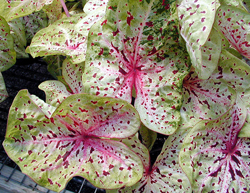 Caladium
CaladiumBegonia. Almost all colors of tuberous begonias are available in upright or trailing types with several distinctly different flower forms. Grown as a pot plant, in window boxes, or as a bedding plant in shaded areas outdoors, it is a handsome plant in bloom. Plants are somewhat brittle. Well-drained soils are essential. Pre-sprout tubers indoors to increase length of the growing season outdoors. Plant shallowly so the top of tuber is slightly above the soil surface.
Caladium. Caladiums are grown for their foliage, the flowers being rather insignificant. Individual leaves are 6 to 24 inches long and come in an endless combination of red, pink, white, silver and green. Caladiums should be dug and stored over winter. They may be pre-sprouted indoors to extend the growing season. They should be grown in shade and are well adapted to pot culture.
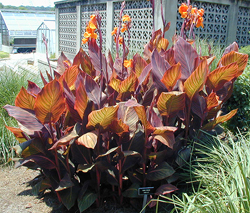 Canna
CannaPhoto by: Bodie Pennisi
Canna. Canna is a favorite summer blooming plant because of its long bloom time and because it thrives in hot weather. Numerous varieties and colors are available ranging from dwarf to very tall varieties. The rhizomes are generally hardy in Zones 8 and 9 but should be lifted and stored during winter at 45-50 degrees F. in Zone 7.
Chionodoxa. Blue and white varieties are available. The flowers are small, thus masses are usually necessary for a good display. Chionodoxa is an excellent bulb for naturalizing and will increase by bulblets and self-seeding. Mowing too soon after bloom can cause decline.
Colchicum. Colchicums are one of the few fall-blooming bulbs. Bright flowers, usually white or lilac, appear suddenly, rising from the soil without foliage. The flowers look much like crocus and are often confused with true autumn crocus. Plant colchicums immediately upon receipt, as they will bloom without being planted.
Convallaria. Usually grown for its fragrant bell-shaped flowers, Lily-of-the-Valley is also an excellent ground cover for shady locations. It is best propagated in the fall by dividing the pips (shoots that appear on the rhizome) when the foliage has developed fully and begun to yellow. Double-flowered and pink varieties are also available. Lily-of-the-Valley need moisture. Do not plant in dry areas.
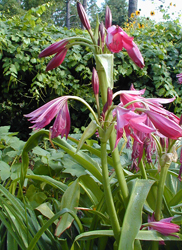 Crinum
CrinumPhoto by: Bodie Pennisi
Crinum. Crinums thrive in the South with little care. The plant is grown primarily for its long flower stalks, which bear umbels of as many as 30 lily-like white, pink or rose-red blooms. Several species and varieties are cultivated; the variegated pink and white is more common. The bulbs are very large, sometimes exceeding 6 inches in diameter. Full sun required.
Crocus. Numerous crocus species, hybrids and varieties are cultivated. The large-flowered Dutch crocus are largely hybrids derived from C. vernus. Many colors are available. The fall, winter and early spring flowering varieties are particularly valued for their time of bloom. Many species naturalize freely from cormels and by self-seeding.
Cyclamen. Miniature relatives of the florists' cyclamen, hardy cyclamen are excellent for naturalizing in shady areas. Colors range from white to crimson. Tubers may go dormant in mid summer under high temperatures and low moisture. C. purpurascens, C. hederifolium, C. cilicium, and C. repandum are readily available.
Dahlia. Dahlias are grown primarily as bedding plants or for cut flowers; some of the dwarf varieties are suitable for tub culture. Most bedding types are seed-grown while most cut types are propagated by division of tuberous roots. Many colors and varieties are available with many flower types. Dahlias are not reliably winter hardy outside Zone 9, unless heavily mulched, and should be dug and stored under dry, cool conditions. Tall varieties require staking.
Endymion. Sometimes confused with Siberian Squill, Spanish Bluebell bears much taller flower spikes and blooms much later. Blue, pink and white varieties are available. It too is an excellent choice for naturalizing in wooded areas.
Eranthis. Winter Aconite is valued for its very early flowering habit. The bright yellow flowers cover the ground even when ice and snow are still present. A good naturalizing plant, it will self-seed. Soak tubers 24 hours before planting.
Fritillaria. This is one of the showiest spring-flowering bulbs. The flower stalk is topped by a crest of leaves beneath which hang large clusters of 2-inch reddish-orange, bronze, red or yellow flowers. F. meleagris is also cultivated and produces unusual purple and white checkered flowers.
Galanthus. Snowdrops are among the first flowers to bloom in spring. They grow well under deciduous trees and are good for naturalizing and random planting. The drooping white flowers have a green splotch around the inner segments. G. elwesii (Giant Snowdrop) is larger and flowers slightly later.
Gladiolus. Gladiolus is best grown as a cut flower. Because the lower florets wither well before the upper ones open, it is generally not an attractive plant in the landscape. You should make successive plantings to ensure flowers for continuous cutting. Numerous varieties and colors are available. The corms are not reliably winter hardy in Zone 7 and should be lifted and stored at 35-40 degrees. Mounding the soil around the base of the plants will help prevent them toppling over.
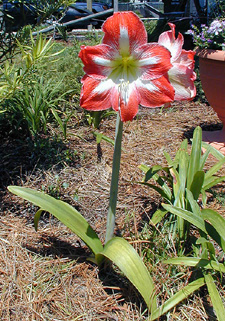 Hippeastrum
HippeastrumPhoto by: Bodie Pennisi
Hippeastrum. A spectacular plant in bloom, amaryllis have long been cultivated indoors. They can be grown outdoors as summer blooming bulbs. Some hybrids and species are hardy outdoors in Zone 9. When planted outdoors, the nose of the bulbs should be just at the soil surface. In pots, leave about half the bulb above the soil surface.
Hyacinthus. Few flowers can boast the extensive color range and fragrance of hyacinths. H. orientalis is hardy but not notably persistent; the bulbs eventually decline, becoming too small to flower. H. orientalis albulus (French-Roman Hyacinth) has smaller flowers but is said to be more persistent.
Hymenocallis. It produces fragrant 3- to 4-inch intricately arranged white flowers in midsummer on tall leafless stalks. Several varieties are available, one with yellow flowers. The plant is not reliably winter hardy outside Zone 9 and should be lifted and stored at 65-70 degrees F.
Ipheion. Starflower produces abundant bluish white flowers. It is excellent for naturalizing and multiplies rapidly. It is sometimes used in lawns, which can be a problem since the grass usually needs cutting before the plant's foliage matures.
Iris. The Iris genus is extremely diverse and many species and hybrids are cultivated. Several classification schemes exist. They are loosely divided into bulbous iris and rhizomatous iris. The bulbous iris, e.g. I. danfordiae (Danford Iris) and I. reticulata (netted Iris), are small and generally bloom very early. The rhizomatuous iris, e.g. I. hybrids (Bearded Iris), I. siberica (Siberian Iris), and I. kaempferi (Japanese Iris), are taller (up to 3 feet) and bloom from mid spring to early summer. The cultural requirements and differences are too diverse to discuss here.
Leucojum. Small white bell-shaped flowers tipped with green are borne on each stem. They are good for naturalizing and random planting in shrub borders. L. aestivum (Summer Snowflake) is taller and blooms later. L. autumnale (Autumn Snowflake) is fall blooming.
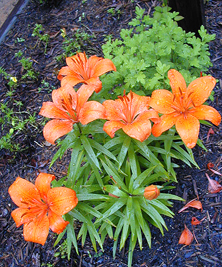 Lilium
LiliumPhoto by: Bodie Pennisi
Lilium. Numerous lily species and cultivars are available. Bloom times range from May to September. All colors are available except blue. Various flower forms exist. It is an excellent border plant and cut flower. The larger hybrids are effective as single specimens; the species are more often used in mass. Tall varieties should be staked.
Lycoris. In late July or early August, I. squamigera suddenly appears, hence the name "Surprise Lily." Long leafless flower stalks bear 4 to 12 lilac-pink, lily-like flowers. The foliage appears in early spring and dies back to the ground by early summer. L. radiata (Red Spider Lily) and L. aurea (Yellow Spider Lily) are also members of this genus. Both bloom later. L. aurea is less hardy.
Muscari. The tiny purple flower clusters resemble clusters of grapes. Common Grape Hyacinth is easy to grow, and naturalizes quickly. It is frequently inter-planted with other spring bulbs. A white variety is also available. M. armeniacum (Armenian Grape Hyacinth) is larger and more robust; several blue and double-flowered varieties are available.
 Narcissus
NarcissusPhoto by: Bodie Pennisi
Narcissus. There are 11 major divisions of the genus Narcissus. Confusion often arises because the generic name Narcissus is also used as a common name. Daffodils, like jonquils, are but one type of narcissus. Hundreds of varieties are available. The cultural requirements for all divisions are essentially identical, but the size, color, time of bloom, etc., vary and are too complex to discuss here.
Polianthes. The fragrant tuberose became so associated with funerals that its popularity declined. It is a superb cut flower, however, and grows well in Georgia. It is usually treated as a tender bulb. Large size bulbs have a tendency to split into smaller bulbs, which may require an additional year or two to reach flowering size.
Scilla. Siberian Squill is valued for its early bright blue flowers. It is excellent for naturalizing, especially in wooded areas. Several varieties are available including one with white flowers.
Sternbergia. An underused bulb, Sternbergia is valued for its fall-flowering habit. It is frequently mistaken for autumn crocus. The plant grows best in full sun and can remain undisturbed for years. Foliage is produced in the fall and remains green during winter.
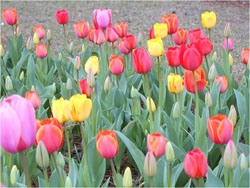 Tulipa
TulipaPhoto by: Bodie Pennisi
Tulipa. Numerous tulip species and cultivars exist. The classification scheme for cultivated tulips lists 15 divisions based on time of bloom and parentage. More than 4,000 varieties are in existence. Virtually all colors are represented. The tulip is considered by many the premier spring bulb. Most tulips also make excellent cut flowers. Many tulips are not notably persistent in the south and usually decline after the first year. Size, flower type, time of bloom, etc., are too complex to discuss here.
Zephyranthes. Z. atamasco (Atamasco Lily, Rain Lily, Fairy Lily) is often seen along the roadsides of Georgia, frequently along drainage ditches and wet meadows. Flowers often appear following a soaking rain. Other species and hybrids are also available. These native bulbs can be grown in shady, moist locations or in full sun if moisture is present.
Commonly Grown Bulbs Suitable for Georgia
| Botanical Name | Common Name |
Hardiness | Planting Time | Planting Depth | Spacing | Flowering Time | Height at Flowering |
| Spring Flowering | |||||||
| Allium giganteum | Giant Onion | H | F | 4" | 6-18" | late | 3-5' |
| Anemone blanda | Greek Windflower | H | F | 2" | 3" | early | 6" |
| Chionodoxa luciliae | Glory-of-the-Snow | H | F | 2" | 3" | early | 5" |
| Convallaria majalis | Lily-of-the-Valley | H | F | 1" | 3-4" | late* | 8" |
| Crocus species & hybrids | Crocus | H | F | 2" | 2-3" | very early to mid* | 4" |
| Cyclamen species | Hardy Cyclamen | H | S | 1-2" | 6-8" | early-mid | 4-5" |
| Endymion hispanicus | Spanish Bluebell | H | F | 3" | 3" | late | 8" |
| Eranthus hyemalis | Winter Aconite | H | F | 2" | 3" | very early | 4" |
| Fritillaria imperialis | Crown Imperial | H | F | 6" | 10" | mid | 3' |
| Galanthus nivalis | Common Snowdrop | H | F | 2" | 2" | early* | 6" |
| Hippeastrum hybrids | Amaryllis | T | S | see text | 1' | late* | 1-2' |
| Hyacinthus orientalis | Hyacinth | H | F | 4" | 5" | mid* | 10" |
| Ipheion uniflorum | Spring Starflower | H | F | 3" | 6" | mid* | 6" |
| Iris species & hybrids | Iris | H | see text | see text | see text | very early to late | see text |
| Leucojum vernum | Spring Snowflake | H | F | 2" | 3" | mid | 9" |
| Muscari botryoides | Common Grape Hyacinth | H | F | 3" | 3" | early | 5" |
| Narcissus species & hybrids | Narcissus, Daffodil, Jonquil | H | F | 3-6" | 3-6" | early-mid* | 6-24" |
| Scilla siberica | Siberian Squill | H | F | 3" | 2" | early | 4" |
| Tulipa species & hybrids | Tulip | H | F | 4-6" | 4-6" | early-late* | 3-30" |
| Zephryanthes species & hybrids | Rain Lily | H | F | 2" | 3-6" | mid | 6-8" |
| Summer Flowering | |||||||
| Achimenes hybrids | Widow's Tears | T | S | ½-1" | 3" | till frost | trailing vine |
| Agapanthus africanus | African Lily | S | S | see text | 24" | till frost* | 12-24" |
| Begonia x tuberhybrida | Tuberous Begonia | T | S | see text | 12" | till frost* | 12-18" |
| Caladium hortulanum | Caladium | T | S | 1" | 12" | -- | 1-2' |
| Canna x generalis | Canna | SH | S | 4" | 15-18" | till frost | 1½-5' |
| Crinum bulbispermum | Milk-and-Wine Lily | H | S or F | 6" | 12-18" | mid | 2-4' |
| Dahlia hybrids | Dahlia | SH | S | 2-6" | 12-36" | till frost | 1-5' |
| Gladiolus x hortulanus | Gladiolus | SH | S | 3-6" | 6" | see text | 1-5' |
| Hymenocallis narcissiflora | Peruvian Daffodil | SH | S | 4" | 12-15" | early* | 18-24" |
| Lilium species & hybrids | Lily | H | early S or F | 4-6" | 9-18" | varies | 2-6' |
| Lycoris squamigera | Magic Lily | H | F | 5" | 6" | mid | 2' |
| Polianthes tuberosa | Tiberose | T | S | 3" | 6-8" | mid-late | 1-4' |
| Fall Flowering | |||||||
| Colchicum autumnale | Autumn Crocus | H | F | 4" | 8" | early | 8" |
| Crocus species | Autumn Crocus | H | F | 2" | 2-3" | early | 4" |
| Cyclamen species | Hardy Cyclamen | H | S | 1-2" | 6-8" | early-late | 4-5' |
| Lycoris radiata | Red Spider Lily | H | F | 5" | 6" | early | 2' |
| Sternbergia lutea | Winter Daffodil | H | F | 2" | 3" | early | 6" |
| Hardiness: T = Tender, S = Semi-hardy, H = Hardy; Planting Time: F = Fall, S = Spring *May be flowered indoors out-of-season |
|||||||
Additional Bulbs to Try
| Botanical Name | Common Name |
| Belamcanda chinensis | Blackberry Lily |
| Bletilla striata | Hardy Orchid |
| Camassis quamash | Common Camassis |
| Clivia Minita* | Kafir Lily |
| Colocasis esculenta* | Elephant's Ear |
| Crocosmia x crocosmiiflora | Montbretia |
| Eremurus species & hybrids | Foxtail Lily |
| Erythronium dens-canis | Dog-Tooth Violet |
| Eucharis grandiflors* | Amazon Lily |
| Freesia x hybrida* | Freesia |
| Gloriosa superba | Climbing Lily |
| Ixia species* | African Corn Lily |
| Nerine sarniensis* | Guernsey Lily |
| Ornithogalum nutans | Star-of-Bethlehem |
| Ranuncalus asiaticus* | Persian Buttercup |
| Tritonia crocata | Montbretia |
| Zantedeschia species* | Calla Lily |
| * tender bulbs | |
Status and Revision History
Published on Jul 14, 2004
In Review for Major Revisions on Feb 24, 2009
Published with Minor Revisions on Oct 27, 2009
Published with Full Review on Oct 01, 2012
Published with Full Review on Feb 01, 2016
Published with Full Review on May 27, 2020
Published with Full Review on Apr 11, 2023
Published with Full Review on Apr 09, 2024


























































